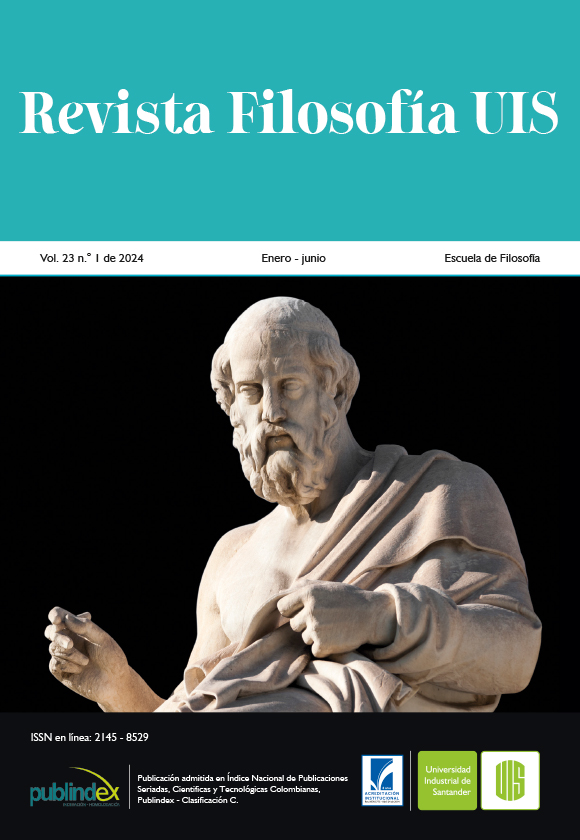Analysis of the Concept of Mimesis in Ancient Greece and in Dialogues III and X of Plato's Republic
Published 2024-01-02
Keywords
- mimesis,
- theater,
- actor,
- poetry,
- poets
- appearances ...More
How to Cite
Copyright (c) 2024 Revista Filosofía UIS

This work is licensed under a Creative Commons Attribution 4.0 International License.
Abstract
In this article, the concept of mimesis will be analyzed, a term of great relevance in ancient Greece, especially in art, and which was the subject of reflection by prominent Greek philosophers, one of them was Plato, who offered a profound and provocative interpretation of mimesis in his philosophical work. This analysis will show that it is a term that adapts to
different contexts, which allows it to be applied in different ways. Such applications make it possible to see that art should not be interpreted in an exclusive way, for example, because it would unnecessarily reduce the meaning of the term. To show what has been stated, the article is divided into three sections: initially an análisis of mimesis in pre-Socratic thought will be made, then the term will be examined in books II and III of The Republic, and finally, will analyze and show the evolution of the term in The Republic of the Athenian philosopher and why Plato considers, in book X, that mimetic poetry has no value of knowledge.
Downloads
References
- Castillo M, M. (2016). A través del espejo y lo que Platón encontró allí. Mímesis entre lógos y alétheia. Praxis Filosófica, (42), pp. 33-58.
- Castor. M. (2015). Arqueología de la mímesis humana. La condición paradójica de la acción imitativa. Revista de filosofía, 40 (2), pp. 45-61.
- Demócrito. (1986). Los filósofos presocráticos, vol. III. (A, Paratti., C, Eggers Lan., M, Santa Cruz de Prunes. y N, Cordero, trads.). Gredos.
- García, P. I. (2008). La Mímesis en los Diálogos de Platón. Luso Española de Ediciones.
- Guthrie, W. K. C. (1999). Historia de la filosofía griega, vol. I. Gredos.
- Gutiérrez. G. (2016). Sobre el concepto de mímesis en la Antigua Grecia. Byzantion Nea Ellas, (35), pp. 97-106.
- Havelock. E. (1994). Prefacio a Platón. (R, Buenaventura, trad.). Visor.
- Nietzsche. F. (2013) Obras completas, Escritos filosóficos: introducción al estudio de los diálogos de Platón, vol. II. Tecnos Editorial.
- Pájaro C. (2014). De Platón para los poetas: crítica, censura y destierro. Eidos. (20), pp. 109-144. http://dx.doi.org/10.14482/eidos.20.5910
- Platón (1988). Diálogos IV: República. (C. Eggers Lan, trad.). Gredos.
- Rodríguez. F. (1983). Fiesta, comedia, y tragedia. Sobre los orígenes del teatro. Alianza Editorial.
- Soares. L. (2013). La significación ética de la mímesis poética en la República de Platón y su influencia en la estética de Gadamer y Badiou. Cuadernos de Filosofía. (60), pp. 27-42.
- Suñol. V. (2004). Aprendizaje y placer mimético en la poética de Aristóteles. (Tesis de grado). Universidad Nacional de La Plata. Facultad de Humanidades y Ciencias de la Educación. En Memoria Académica. http://www.memoria.fahce.unlp.edu.ar/tesis/te.210/te.210.pdf
- Suñol. V. (2008). Mímesis en Aristóteles. Reconsideración de su significado y su función en el corpus Aristotelicum. (Tesis doctoral). Universidad Nacional de La Plata. Facultad de Humanidades y Ciencias de la Educación. http://www.memoria.fahce.unlp.edu.ar/tesis/te.283/te.283.pdf

